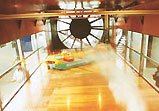
MIGUEL BOYAYANWithin the tunnel: models receive gases blown by the helix blower MIGUEL BOYAYAN
A chamber of some 40 meters in length by almost 4 meters in height, mounted upon a steel, glass and wooden frame, where a large helix blower installed at one end can move the air at speeds of up to 90 km per hour. Inaugurated at the beginning of June at the Technology Research Institute (IPT), this chamber has received the name of Wind Tunnel for Atmospheric Limit Chamber. Throughout the world there are some fifteen other similar pieces of equipment. The tunnel is a tool for the study of the dispersion of pollutants generated by smokestacks, burnings or motor combustion. It will also be used in the analysis of the effects of the wind on transmission towers, oil drilling platforms, airports and in the structures and top floors of residential and industrial buildings.
The tunnel was projected and developed at the IPT and cost R$ 1 million, some R$ 300,000 coming from the institute itself and almost R$ 700,000 coming from FAPESP. The project can also count upon a partnership with the Environment Sanitation Technology Company (Cetesb) and from the Astronomy, Geophysics and Atmospheric Sciences Institute of the University of São Paulo (USP). Even before being inaugurated, the tunnel was sounded out for use by telecommunication companies, interested in the influence of wind on the structures of transmission towers.
“One week after its inauguration, we received a consultation from the Polytechnic School of USP about the possibility of carrying out a test for an industrial structure to be built in the town of Americana”, says Marcos Tadeu Pereira, head of the Flow Group, responsible for the equipment. Unusual for the researchers was a request for the recording of a musical video clip inside the tunnel, which will be attended to.
Urban complex
The tests in the interior of the tunnel will be done with models of streets, buildings, factories and cars. The effects of the gases will be monitored by a type of robot installed in a metallic mounted assembly which positions the measuring instruments into the models. With the results of the measurements, it will be possible, if it were to be the case, to carry out intervention at the locations with the help of plaques that favor, for example, the dispersion of pollutants over the windows of a hospital or even to suggest the building of higher smokestacks. The IPT team is going to issue bulletins vetoing the construction of buildings in areas where the dispersion of pollutants and wind is jeopardized.
On the day of the inauguration of the tunnel there was also registered, on a plaque at the side of the equipment, the celebration of FAPESP’s 40 years. Now it only remains that good winds mark the trajectory of the tunnel within the system of science and technology in the country.
The project
Wind Tunnel of Atmospheric Limit Chamber (nº 98/15402-5); Modality
Program of Multi-use Equipment; Coordinator Marcos Tadeu Pereira – IPT; Investment R$ 697,781.33
